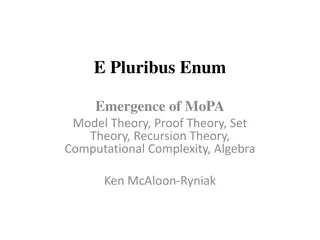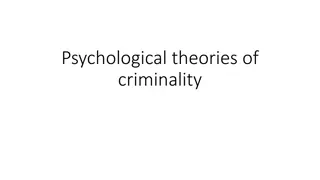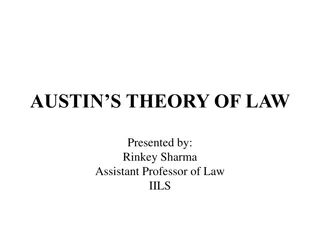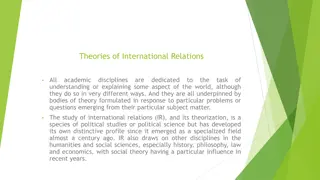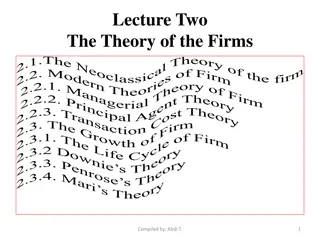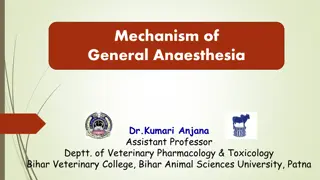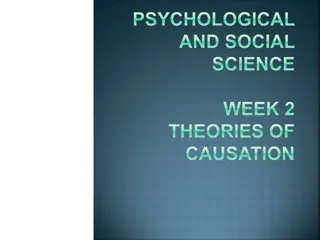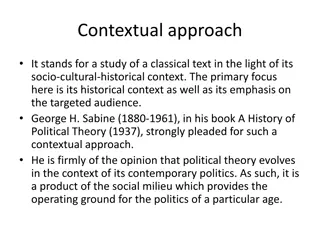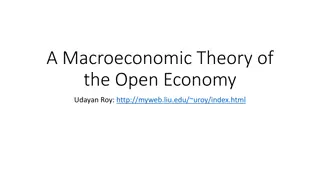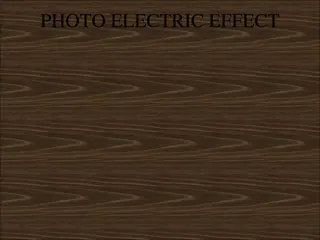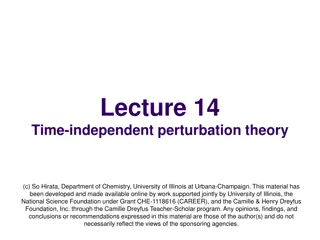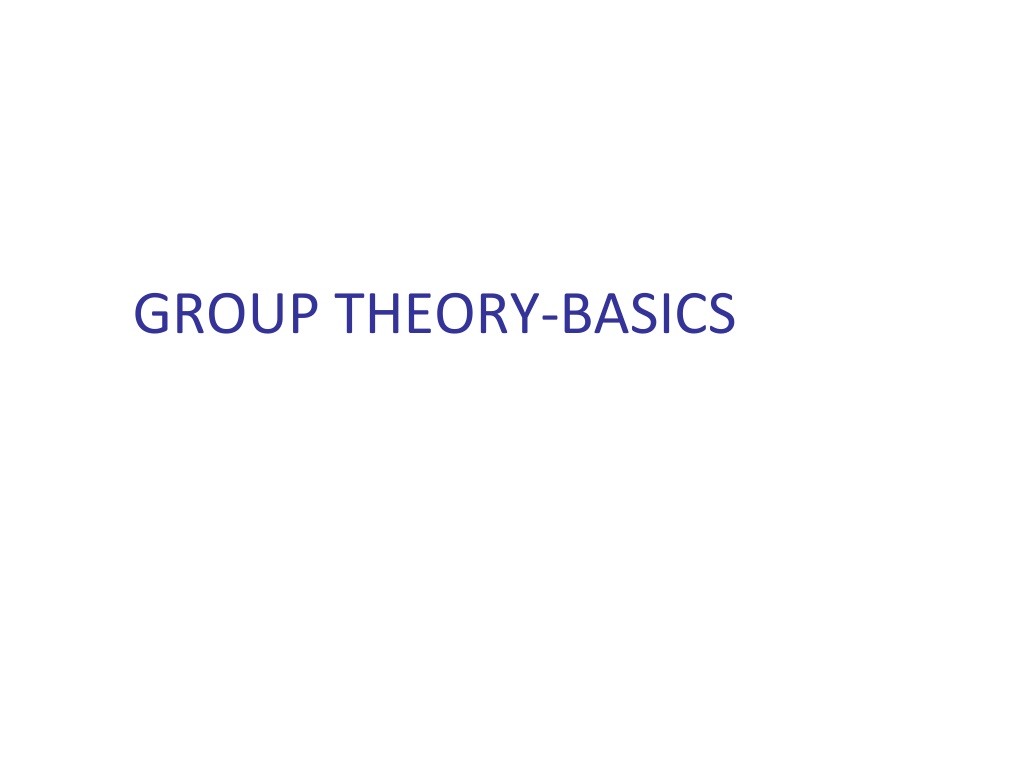
Introduction to Group Theory Basics
Explore the fundamental concepts of group theory, including basic definitions, simple examples, subgroups, rearrangement lemma, symmetric groups, cosets, factor groups, homomorphisms, and direct products. Dive into the world of abstract algebra with realizations and examples of various groups such as cyclic groups, dihedral groups, and permutation groups.
Download Presentation

Please find below an Image/Link to download the presentation.
The content on the website is provided AS IS for your information and personal use only. It may not be sold, licensed, or shared on other websites without obtaining consent from the author. If you encounter any issues during the download, it is possible that the publisher has removed the file from their server.
You are allowed to download the files provided on this website for personal or commercial use, subject to the condition that they are used lawfully. All files are the property of their respective owners.
The content on the website is provided AS IS for your information and personal use only. It may not be sold, licensed, or shared on other websites without obtaining consent from the author.
E N D
Presentation Transcript
Basic Group Theory 1 2 3 4 5 6 7 Basic Definitions and Simple Examples Further Examples, Subgroups The Rearrangement Lemma & the Symmetric Group Classes and Invariant Subgroups Cosets and Factor (Quotient) Groups Homomorphisms Direct Products
1 Basic Definitions and Simple Examples Definition 1: Group a , b , c G { G, } is a group if 1. a b G ( closure ) 2. ( associativity ) ( a b ) c = a ( b c ) 3. e G ( identity ) e a = a e = a 4. a 1 G a 1 a = a a 1= e ( inverse ) Definition in terms of multiplication table (abstract group): G e a b e e e e a e b e a b a a e a a a b a a a a b b b e b a b b b b a b b
Realizations: C1 e e Example 1: C1 e {e} = { 1 } Realizations: e a Example 2: C2 {e,a} = { 1, 1} a e Reflection group: C = { E, } Rotation group: C2= { E, C2} Cn = Rotation of angle 2 /n Realizations: e a b Example 3: C3 Rotation group: C3= { E, C3, C3 1} Cyclic group: C3= { e, a, a2 ; a3=e } { 1, e i 2 /3, e i 4 /3} a b e b e a Cyclic permutation of 3 objects { (123), (231), (312) } Cyclic group : Cn= { e, a, a2, a3, an-1 ; an= e }
Definition 2: Abelian (commutative) Group Common notations: G is Abelian if a b = b a a,b G + e 0 Definition 3: Order Order g of group G = Number of elements in G Example 4: Dihedral group D2 Simplest non-cyclic group is e a b c a e c b D2= { e, a = a 1, b = b 1, c = a b } ( Abelian, order = 4 ) b c e a c b a e Realizations: D2= { symmetries of a rectangle } = { E , C2, x, y} = { E, C2 , C2', C2" }
2 Further Examples, Subgroups The simplest non-Abelian group is of order 6. { e, a, b = a 1, c = c 1, d = d 1, f = f 1} Aliases: Dihedral group D3, C3v, or permutation group S3. 1 3 2 2 1 3 3 2 1 C32 C32 e C3 C32 e a b c d f C3 C32 1 2 3 e a b e f c d e 2 3 1 C3 3 1 2 b e a d f c e C3 c d f e a b C32 e C3 d f c b e a C32 C3 e f c d a b e Symmetries of an equilateral triangle: C3v= { E, C3, C32, 1, 2, 3} D3 = { E, C3, C32, C2', C2'', C2''' }
S3= { e, (123), (132), (23), (13), (12) } ( ) = cyclic permutations e (123) (132) (23) (13) (12) e (12) (23) (31) (123) (321) (123) (132) e (12) (23) (13) (12) e (123) (321) (23) (31) (132) e (123) (13) (12) (23) (23) (321) e (123) (31) (12) (31) (123) (321) e (12) (23) (23) (13) (12) e (123) (132) (123) (31) (12) (23) (321) e (13) (12) (23) (132) e (123) (321) (23) (31) (12) e (123) (12) (23) (13) (123) (132) e Tung's notation
Definition 4: Subgroup { H G, } is a subgroup of { G , } . Example 1: D2 = { e, a, b, c } 3 subgroups: { e, a }, { e, b }, { e, c } Example 2: D3 S3 { e, a, b = a 1, c = c 1, d = d 1, f = f 1} 4 subgroups: { e, a, b } , { e, c }, { e, d }, { e, f } Infinite Group : Group order = () m TT m = Z d Some subgroups: Td= { T(n) | n } n n E.g. Continuous Group : Elements specified by continuous parameters E.g. Continuous translations T Continuous rotations R(2), R(3) Continuous translations & rotations E(2), E(3)
3. The Rearrangement Lemma & the Symmetric Group Lemma: Rearrangement where p, b, c G p b = p c b = c Proof: p 1both sides Corollary: p G = G rearranged; likewise G p 12 3 ppp p = ( i q pqqi = n p Permutation: pi i ( Active point of view ) ) ( ) i i 1 2 3 n ( ) Product: p q = ( pk k) ( qi i ) 1 2 3 p qp p p p q q q q = qqq q ppp p = i q p i = 123 1 2 3 n n 1 2 3 n q q q q n n n 12 3 1 2 3 p p p = n p 1 2 3 1 2 3 n 1 q q q n q 1 q 2 q 3 q n q 2 3 (Rearranged)
1 2 3 n 1 2 3 = ()()() 1 p q p q p q = n p () n p q ( ) p q p = p qp p p j q j 2 3 1 q 2 q 3 q n q 123 123 = n n e Identity: 1 2 3 1 n p ( )( )( ) ( ) 1 1 1 2 pp p p = p p p = n Inverse: 1 1 3 p 1 1 2 3 2 3 n n i pi Symmetric (Permutation) group Sn { n! permutations of n objects } p p p p p p p p n-Cycle = ( p1, p2, p3, , pn ) 1 2 3 n 2 3 4 1 Every permutation can be written as a product of cycles
Example 1 2 3 3 2 1 q = 1 2 3 2 1 3 = p ( )() 1 32 = ( )() 1 2 3 = 123123 213321 p q = 321123 312321 = 1 2 3 3 1 2 ( ) 1 3 2 = = 123123 321213 q p = 213123 231213 = 1 2 3 2 3 1 ( ) 1 2 3 = = 2 1 3 1 2 3 = 1 2 3 2 1 3 p = p = 1 = q q 1 ( )1 312 p q = 1 2 3 2 3 1 ( ) 1 2 3 = = = qp 123
Definition 5: Isomorphism 2 groups G & G ' are isomorphic ( G G ' ) , if : G G ' gi a 1-1 onto mapping gigj= gk gi' gigj' = gk' Examples: Rotational group Cn cyclic group Cn D3 C3v S3 Theorem 1: Cayley Every group of finite order n is isomorphic to a subgroup of Sn Let G = { g1, g2, , gn} . The required mapping is 12 j j g pj j = 1 2 jk j jk g g gp pjj jk k k = = = Proof: n = j k gg g where : G Sn k j n j 1 2 n 12 1 2 n 1 2 j = n n n k j k j k 12 k 1 2 n kj p
Example 1: C3= { e, a, b = a2; a3=e } = { g1, g2, g3} 1 2 31 2 3 e ep = = ( ) 231 1231 2 3 a a p = = e a b 1 2 3 a b e 2 3 1 ( ) () () 3 1 2 b e a 1 2 3 312 1231 3 2 = b p ( ) = b C3 { e, (123), (321) }, subgroup of S3 e a b c 1 2 3 4 Example 2: D2= { e, a = a 1, b = b 1, c = a b } 1 2 3 41 2 3 4 1 2 3 4 e ep = = 1 2 3 41 2 3 4 2 1 4 3 a ap = 1 2 3 41 4 2 3 4 3 2 1 c cp = a e c b 2 1 4 3 ( ) ( ) ( ) ( ) b c e a 3 4 1 2 c b a e 4 3 2 1 () () = 1 2 3 41 3 2 4 3 4 1 2 bp = () () = b () () = D2 { e, (12)(34), (13)(24), (14)(23) }, subgroup of S4
Example 3: C4= { e = a4, a, a2, a3} a2 a3 a3 e a a2 a3 1 2 3 4 a a2 a3 e 2 3 4 1 1 2 3 41 2 3 4 1 2 3 4 ep = 1 2 3 41 2 3 4 2 3 4 1 a ap = 1 2 3 41 3 2 4 a ( ) ( ) ( ) ( ) = ( ) = () () 3 4 1 2 ap = 1 2 3 41 4 3 2 4 1 2 3 a a p = e e a a2 3 4 1 2 e a 4 1 2 3 = ( ) = 2 2 3 3 D2 { e, (1234), (13)(24), (1432) }, subgroup of S4 Let S be a subgroup of Snthat is isomorphic to a group G of order n. Then The only element in S that contains 1-cycles is e ( else, rearrangement therem is violated ) All cycles in a given element are of the same length ( else, some power of it will contain 1-cycles ) E.g., [ (12)(345) ]2= (1) (2) (345)2 Only 1 group for e ach prime order If order of G is prime, then S can contain only full n-cycles, ie, S is cyclic
4. Classes and Invariant Subgroups Definition 6: Conjugate Elements Let a , b G. b is conjugate to a, or b~a, if p G b = p a p 1 Example: S3 (12) ~ (31) since (23) (31) (23) 1= (23) (132) = (12)(3) = (12) (123) ~ (321) since (12) (321) (12) = (12) (1)(23) = (123) 1 = p p q p p p 1 n p q p Exercise: Show that for p, q Sn, 1 q n q 1 1 p p = 1 q q p n n 1 n = p Hint: n q
Def: ~ is an equivalence relation if a ~ a (reflexive) a~b b~a (symmetric) a~b, b~c a~c (transitive) Conjugacy is an equivalence relation Proof : a e a e = (reflexive) ~ aa 1 1 p = ~ a bp G a p b = (symmetric) ~ ba 1 q b q = 1 b pa p = 1 qp G 1 1 , a p b p b = = ~ , ~ , a b b c p q G q c q 11 rc r = ap q c q p = ~ ac 1 r p qG = (transitive)
An equivalence relation partitions (classifies members of) a set. Definition 7: Conjugate Class Let a G, the conjugate class of a is the set = { p a p 1| p G } Comments: Members of a class are equivalent & mutually conjugate Every group element belongs to 1 & only 1 class e is always a class by itself For matrix groups, conjugacy = similarity transform
Example 1: S3 (3 classes): 1= { e } 2= { (12), (23), (31) } 3= { (123), (321) } ( 1 i p q p q qq = identity 2-cycles 3-cycles Permutations with the same cycle structure belong to the same class. ) Example 2: R(3) (Infinitely many classes): i u = unit vector Let Ru( ) be a rotation about u by angle . () () 1R R RR R = u u () 3 RR Class: ( ) = { Ru( ) ; all u } = { All rotations of angle } Example 3: E3(Infinitely many classes): Let Tu(b) be a translation along u by distance b. Class: (b) = { Tu(b) ; all u } ( ) ( ) 1R R T b R T b = u u RE = { All translations of distance b } 3
Def: Conjugate Subgroup Let H be a subgroup of G & a G. H' = { a h a 1| h H } = Subgroup conjugate to H Exercise: Show that H' is a subgroup of G Show that either H H' or H H' = e Definition 8: Invariant Subgroup H is an invariant subgroup of G if it is identical to all its conjugate subgroups. H = { a h a 1| h H } a G i.e., Examples: { e, a2} is an invariant subgroup of C4= { e = a4, a, a2, a3} { e, (123), (321) } is an invariant subgroup of S3but { e, (12) } isn't Tdmis an invariant subgroup of Td
Comments: An invariant subgroup must consist of entire classes Every group G has 2 trivial invariant subgroups {e} & G Existence of non-trivial invariant subgroup G can be factorized Definition 9: Simple & Semi-Simple Groups A group is simple if it has no non-trivial invariant subgroup. A group is semi-simple if it has no Abelian invariant subgroup. Examples: Cnwith n prime are simple. Cnwith n non-prime are neither simple nor semi-simple. n = p q { e, Cp, C2p, , C(q 1) p} is an Abelian invariant subgroup S3is neither simple nor semi-simple. { e, (123), (321) } is spoiler. SO(3) is simple but SO(2) is not. Spoilers: Cn
5 Cosets and Factor (Quotient) Groups Definition 10: Cosets Let H = { h1, h2, } be a subgroup of G & p G H. Then p H = { p h1, p h2, } is a left coset of H, & H p = { h1 p, h2 p, } is a right coset of H. Neither p H, nor H p, is a subgroup of G (no e) All cosets of H have the same order as H ( rearrangement theorem) Lemma: Either p H = q H or p H q H = Proof: If hi& hj p hi= q hj p H = q hk H = q H Negation of above gives 2nd part of lemma. p = q hjhi 1= q hk qH Lagrange theorem Corollary: G is partitioned by cosets of H.
Theorem 2: Lagrange ( for finite groups ) H is a subgroup of G Order(G) / Order(H) = nG/ nH e (123) (132) (23) (13) (12) (123) (132) e (12) (23) (13) (132) e (123) (13) (12) (23) (23) (13) (12) e (123) (132) (13) (12) (23) (132) e (123) (12) (23) (13) (123) (132) e Examples: S3 H1= { e, (123), (321) }. M = (12) H1= (23) H1= (31) H1 = { (12), (23), (31) } One coset: H2= { e, (12) } . M1= (23) H2= (321) H2= { (23), (321) } M2= (31) H2= (123) H2= { (31), (123) } Two cosets:
Thm: H is an invariant subgroup pH = Hp Proof: H invariant pHp 1= H Theorem 3. Factor / Quotient Group G/H Let H be an invariant subgroup of G. Then G/H { { pH | p G }, } with pH qH (pq) H is a (factor) group of G. Its order is nG/ nH. Example 1: C4= { e = a4, a, a2, a3} H = { e, a2} is an invariant subgroup. H M M H Coset M = a H = a2H = { a, a3}. Factor group C4/H = { H, M } C2
Example 2: S3= { e, (123), (132), (23), (13), (12) } H = { e, (123), (132) } is invariant e (123) (132) (23) (13) (12) (123) (132) e (12) (23) (13) (132) e (123) (13) (12) (23) Coset M = { (23), (13), (12) } (23) (13) (12) e (123) (132) Factor group S3 /H = { H, M } C2 C3v / C3 C2 (13) (12) (23) (132) e (123) (12) (23) (13) (123) (132) e Example 3: Td = { T(n), n } m= { T(mn), n Cosets: } is an invariant subgroup. T(k) m T(k) m T(j) m= T(k+j) m k = 1, , m 1 & T(m) m = m Products: Factor group: / m= { { T(k) m| k = 1, , m 1 }, } Cm Caution: m
6 Homomorphisms Definition 11: Homomorphism G is homomorphic to G' ( G ~ G' ) if ping from G to G', i.e. a group structure preserving map g' = (g) : G G' g a b = c a' b' = c' Isomomorphism: is invertible ( 1-1 onto ). Example: : S3 C2 with (e) = [(123)] = [(321)] = e [(23)] = [(31)] = [(12)] = a is a homorphism S3~ C2.
Theorem 4: Let : G G' be a homomorphism and Kernel = K = { g | (g) = e' } Then K is an invariant subgroup of G and G/K G' Proof 1 ( K is a subgroup of G ): is a homomorphism: a, b K (ab) = (a) (b) = e' e' = e' ab K (closure) (ae) = (a) (e) = e' (e) = (e) = (a) = e' (e) = e' e K (identity) (a 1a) = (a 1) ( a) = (a 1) e' = (a 1) = (e) = e' a 1 K (inverse) Associativity is automatic. QED
Proof 2 ( K is a invariant ): Let a K & g G. ( g a g 1) = (g) (a) ( g 1) = (g) ( g 1) = (g g 1) = (e) = e' g a g 1 K Proof 3 ( G/K G' ): G/K = { pK | p G } ( pa ) = ( p ) ( a ) = ( p ) e' = ( p ) i.e., maps the entire coset pK to one element ( p ) in G'. Hence, : G/K G' with ( pK ) = ( p ) = ( q pK ) is 1-1 onto. ( pK qK ) = [ (pq)K ] = ( pq ) = ( p) ( q) = ( pK) (qK ) is a homomorphism. a K QED
Kernel G/K G'
7 Direct Products Definition 12: Direct Product Group A B Let A & B be subgroups of group G such that a A & b B a b = b a g G, a A & b B g = a b = b a Then G is the direct product of A & B, i.e, G = A B = B A Example 1: C6= { e = a6, a, a2, a3, a4, a5} Let A = { e, a3} & B = { e, a2, a4} a b = b a trivial since C6is Abelian e = e e, a = a3a4, a2= e a2, a3= a3e, a4= e a4, a5= a3a2 C6= A B C2 C3
Example 2: O(3) = R(3) { e, IS } Theorem 5: G = A B A & B are invariant subgroups of G G/A B, G/B A Proof: g = a b g a' g 1= a b a' b 1a 1= a a' b b 1a 1= a a' a 1 A A is invariant ; dido B. G = { a B | a A } G/B A & similarly for B G/B A does not imply G = A B Caution: Example: S3 H = { e, {123}, {321} } is invariant. Let Hi= { e, (j k) } ( i,j,k cyclic ) Then S3/H Hi but S3 H Hi






